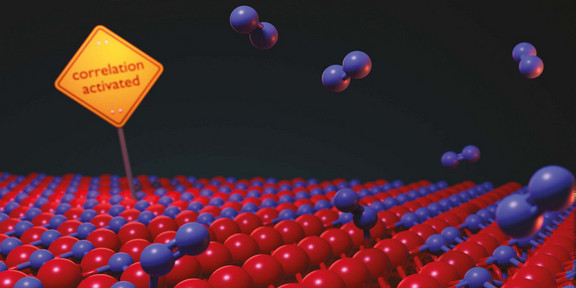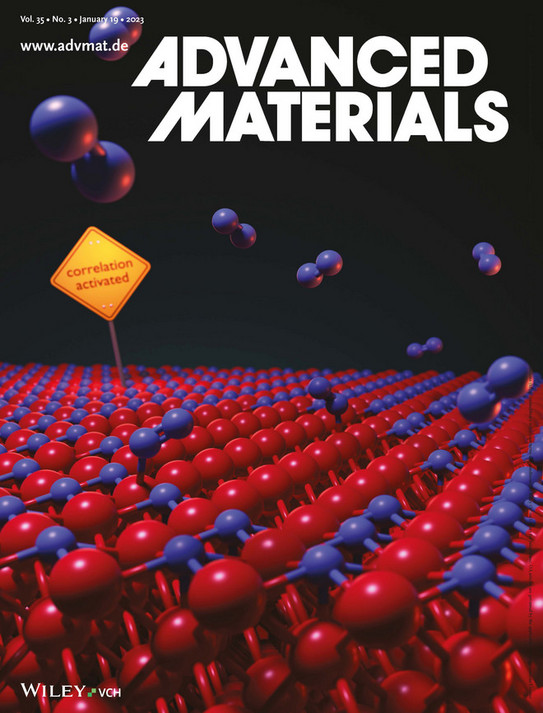TU physicists explore hybrid interfaces and magnetic phenomena
- News
- Research

The research group led by Prof. Mirko Cinchetti from the Faculty of Physics at TU Dortmund University was able to publish two articles in the renowned journal "Advanced Materials". The team investigates magnetic phenomena on ultrashort time scales and aims to manipulate the magnetic and electronic properties of new materials specifically with light. The research forms the basis for numerous possible applications - from information technology to spin electronics.
Understanding hybrid interfaces - with experiment and simulation
In the first publication, Prof. Cinchetti and first author PhD student David Janas, together with an international team, explored the question of how the binding of foreign atoms or molecules affects the properties of magnetic metal surfaces. When a surface is completely and orderly covered with such bound particles, an interface with uniform electronic and magnetic properties is formed. Such hybrid interfaces play an important role in catalytic applications as well as in electronic and spin electronic devices. Better understanding of the physical phenomena and processes that occur at such interfaces can improve their performance for new technologies.
In their current work, the TU physicists used spectroscopic methods to measure a high-purity iron film in ultrahigh vacuum and investigate the changes caused by a single layer of oxygen atoms on the surface. The measurement method is so-called spin-resolved pulse microscopy: a technique with which the electronic and magnetic structure of solids as well as their surfaces can be completely recorded.
The experimental results were complemented by theoretical simulations showing how the electrons in the metal influence each other. This mutual influence is also known as electron correlation. It is complex and computationally very expensive to include electron correlation in a simulation, which is why it has been largely neglected until now. "With our work, we have now been able to show for the first time that adsorbates - particles bound to the surface - can drastically amplify the correlation effects between the electrons of a metal surface. Such amplification in turn affects the nature of the interface," says David Janas. "In our case, this creates an entirely new class of materials with characteristics that cannot be attributed to either metallic iron or insulating iron oxides."
The team's discovery could herald a paradigm shift, as it shows that electron correlation is not merely to be taken as an abstract theoretical quantity, but is important for understanding interfacial phenomena - and enables the design of novel materials.

Dr. Stefano Ponzoni and Dr. Giovanni Zamborlini from TU Dortmund University are also involved in the publication. The work was carried out within the framework of the EU project INTERFAST together with scientists from Trinity College Dublin (Ireland), Forschungszentrum Jülich, the University of Belgrade (Serbia) and the University of Augsburg.
Controlling magnetic properties ultrafast
In the second publication, Prof. Cinchetti and first author PhD student Fabian Mertens collaborated with an international team to research an antiferromagnetic van der Waals semiconductor (FePS3). The semiconductor belongs to a group of magnetic materials that are promising for applications in information technology and spintronics, especially in terms of their robustness, potential speed and miniaturization. However, in order to use the semiconductors technically, it is necessary to be able to control their magnetic properties.
This is where the TU team's research comes in: Using targeted optical excitation of an electronic d-d junction below the semiconductor's so-called band gap, the team was able to excite a high-frequency (3.2 THz) vibrational mode (phonon) of the iron ions in the semiconductor, which is closely coupled to the magnetic order of the material. Excitation below the bandgap avoids the generation of free electrons and heat. By additionally applying strong magnetic fields, it was possible to hybridize this vibrational mode with a magnon, i.e., a magnetic spin wave - thus producing a coherent magnetic excitation.
In addition, the experiment could be applied to exfoliated layers of a few hundred nanometers thick, laying the foundation for the manipulation of atomic-thin magnetic materials.
David Mönkenbüscher and Dr. Umut Parlak from TU Dortmund University are also involved in the publication. The work was carried out within the framework of the DFG Transregio 160 and the EU project SINFONIA together with researchers from the University of Valencia (Spain), the Johannes Kepler University Linz (Austria) and the University of Konstanz.
Contact









